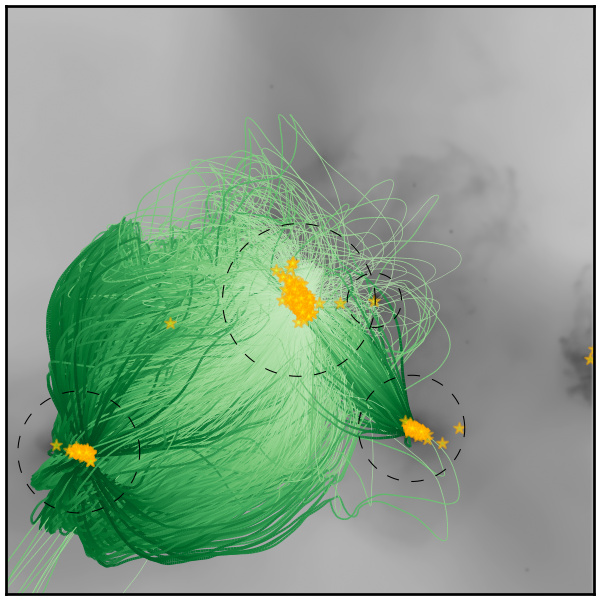Galassia Via Lattea | Public Domain
The renowned science communicator and astronomer Carl Sagan coined the phrase "we are made of starstuff" to highlight the extraordinary origins of the atoms within our bodies. "The nitrogen in our DNA, the calcium in our teeth, the iron in our blood, the carbon in our apple pies were made in the interiors of collapsing stars," Sagan said in his 1980 book Cosmos, released in tandem with the PBS series of the same name.As quintessentially r/whoadude as that reality is, it gets even better, according to a study published Wednesday by the Monthly Notices of the Royal Astronomical Society. Led by Daniel Anglés-Alcázar, an astrophysicist based at Northwestern University's Center for Interdisciplinary Exploration and Research in Astrophysics (CIERA), the authors used supercomputers to run complex simulations of our galactic neighborhood's formation and evolution from the Big Bang to the present. They hypothesize that up to half of the matter in the Milky Way may have originated in other galaxies. Life on Earth is not just made of starstuff, it seems, but extragalactic starstuff (at least in part). Some of these foreign elements were seeded into the Milky Way during mergers with other galaxies in its infancy. But much of it also arrived after being blasted out of host galaxies by supernovas, and then surfing over to us on the "galactic winds," which are streams of charged particles that travel between galaxies as fast as 3,000 kilometers per second (6,710,809 miles per hour).This cross-pollination is known as the baryon cycle, a process that includes outpourings of material that are eventually reabsorbed back into their host galaxies, as well as the transfer of matter between galaxies.Scientists have known that galaxies exchange material for decades, but quantifying exactly how much of the Milky Way's bulk can be traced back to alien galaxies requires sophisticated simulations like the Feedback In Realistic Environments (FIRE) project, which Anglés-Alcázar's team used to generate its results.Animation showing the intergalactic transfer of material to a Milky Way-like galaxy. GIF: Daniel Anglés-Alcázar/Northwestern UniversityFIRE specializes in modelling the murky structural links between galaxies that influence the baryon cycle, which enabled the team to more accurately predict the ratio of material in our galaxy forged inside and outside its borders.The team used two Illinois-based computing centers to process the data: Northwestern's Quest cluster and the National Science Foundation's Extreme Science and Engineering Discovery Environment supercomputers. This led to the estimate that as much as 50 percent of the Milky Way—including parts of yourself, your pet, your world, the hamburger you ate for dinner, and the stars in the night sky—braved the intergalactic wilds to get here."Given how much of the matter out of which we formed may have come from other galaxies," said Anglés-Alcázar, in a statement, "we could consider ourselves space travelers or extragalactic immigrants."Get six of our favorite Motherboard stories every day by signing up for our newsletter.
They hypothesize that up to half of the matter in the Milky Way may have originated in other galaxies. Life on Earth is not just made of starstuff, it seems, but extragalactic starstuff (at least in part). Some of these foreign elements were seeded into the Milky Way during mergers with other galaxies in its infancy. But much of it also arrived after being blasted out of host galaxies by supernovas, and then surfing over to us on the "galactic winds," which are streams of charged particles that travel between galaxies as fast as 3,000 kilometers per second (6,710,809 miles per hour).This cross-pollination is known as the baryon cycle, a process that includes outpourings of material that are eventually reabsorbed back into their host galaxies, as well as the transfer of matter between galaxies.Scientists have known that galaxies exchange material for decades, but quantifying exactly how much of the Milky Way's bulk can be traced back to alien galaxies requires sophisticated simulations like the Feedback In Realistic Environments (FIRE) project, which Anglés-Alcázar's team used to generate its results.Animation showing the intergalactic transfer of material to a Milky Way-like galaxy. GIF: Daniel Anglés-Alcázar/Northwestern UniversityFIRE specializes in modelling the murky structural links between galaxies that influence the baryon cycle, which enabled the team to more accurately predict the ratio of material in our galaxy forged inside and outside its borders.The team used two Illinois-based computing centers to process the data: Northwestern's Quest cluster and the National Science Foundation's Extreme Science and Engineering Discovery Environment supercomputers. This led to the estimate that as much as 50 percent of the Milky Way—including parts of yourself, your pet, your world, the hamburger you ate for dinner, and the stars in the night sky—braved the intergalactic wilds to get here."Given how much of the matter out of which we formed may have come from other galaxies," said Anglés-Alcázar, in a statement, "we could consider ourselves space travelers or extragalactic immigrants."Get six of our favorite Motherboard stories every day by signing up for our newsletter.
Advertisement

Even at such high speeds, it can take billions of years for starburst debris from "nearby" galaxies—meaning those located within one million light years of the Milky Way—to reach us, because the intergalactic medium is so vast.Read More: Milky Way and Andromeda Galaxies Apparently Launch 'Spitballs' at Each Other
Advertisement
